How the Louvre Abu Dhabi Salvator Mundi became a Leonardo-from-nowhere
If it’s not over in opera until the fat lady sings, it’s not over in art attributions until the paint dries and the provenance settles. In art historical disputes over the origins (provenances) or conditions (restorations) of art, the weight of academic study and curatorial politics has assumed a greater importance than the dwindling creative/technical expertise of living artists. That this imbalanced dynamic is culturally destabilising, can perfectly be seen in the Leonardo Salvator Mundi Saga. Following a scholar’s recent re-attribution of the Louvre Abu Dhabi Salvator Mundi to Leonardo’s follower, Bernardino Luini, dedicated supporters of the $450million painting are re-writing its provenance in the wake of a second scholar’s newly discovered documents. The painting itself has not been seen since it was sold at Christie’s, New York, on 15 November 2017 and it is not clear when it might be seen again – the Louvre Abu Dhabi indefinitely postponed its planned launch of the painting a day ahead of a visit by the French Foreign Minister, Jean-Yves Le Drian, to mark the announcement of the museum’s programme of events for the next year.
The first question here is stark: Is the picture that was sold for nearly half a billion dollars an entirely autograph painting by Leonardo or a dressed-up school work? The second question is: Had a proper art historical case been made for this painting before it was exhibited in 2011 at the National Gallery as a Leonardo? In our view, the latter had not happened, partly because no attempt had been made, and partly because on a reading of the available historical evidence, the Leonardo case could not be made. On the former question, the Vienna Times reported scholarly concerns on 17 September 2018 (“What Happened With the 450 Million Dollars Painting”):
“Is there anything wrong with the painting that was auctioned at the Christie’s New York in November 2017 for the world record price of 450 million dollars? Experts suspect that the image of Christ had been doctored before sale. When it was exhibited at the National Gallery London in 2011, there were some doubts: the pedantic Leonardo would never have painted the folds of the robe behind the glass ball, ignoring the refraction of the light. At the 2017 auction, the wrinkles suddenly looked ‘right’. In the magazine ‘Art’ the German specialist Prof. Frank Zöllner (62) [The author of the catalogue raisonné Leonardo da Vinci – the Complete Paintings and Drawings] wrote about Leonardo: ‘The question arises whether the restorers responded with a modification of the folds to the objections of the critics.’ So, a manipulation to seduce connoisseurs and drive up the price? Zöllner: ‘An absurdity, if that happened.'”
On the pre-sale re-restoration, see Dalya Alberge – “Auctioneers Christie’s admit Leonardo Da Vinci painting which became world’s most expensive artwork when it sold for £340m has been retouched in last five years” – and our: “The $450m New York Leonardo Salvator Mundi Part II: It Restores, It Sells, therefore It Is.”
WHAT HAPPENED?
From the first this work has been soaked in mystery. Professor Martin Kemp discloses in his latest book Living with Leonardo: Fifty Years of Sanity and Insanity in the Art World and Beyond that it: “crossed Robert’s [Robert Simon] path in 2005 when it came up for sale at a regional auction house in Louisiana. Robert and his fellow New York art dealer Alexander Parrish, who had also noticed it, thought it might be a bit better than it superficially looked – without imagining that it might be the original. They decided to bid by proxy, and met with success, apparently acquiring it for less than $10,000, which at the time would have seemed like quite a high price.” “Apparently”? For how much? How had it been listed? Who sold it? When? Where? Many have searched and no one has found answers but this serially redone as-if-from-nowhere work has been sold twice already – with a different face of Christ each time – for a total of over half a billion dollars, first in a private sale by Sotheby’s in 2013, reportedly for $75-80 million to the owner of a string of free ports who immediately sold it on to a Russian oligarch for $127 million, and then, famously, by Christie’s, New York, for $450million in 2017. Did that initial opacity pass freely through the National Gallery and into the art market food chain? It might seem so: when the painting was taken to the National Gallery for a private viewing by a select group of experts, “All of the witnesses were sworn to confidentiality”, Kemp has disclosed, “and the painting travelled back to New York with Robert. It was becoming a Leonardo.” The invitation to view, appraise and perhaps authenticate flattered: “We are only inviting two or three scholars.”
Kemp believes that the National Gallery had not included another Leonardo attributed work he supports (the so-called “La Bella Principessa” drawing) in the 2011 Leonardo show because the curators did not accept its attribution and he now feels that that rejection had highlighted: “the rationale for the inclusion of the Salvator Mundi. Was it on the market? Would exhibiting it mean that the National Gallery was tacitly involved in a huge act of commercial promotion? It seemed highly likely that it was also ‘in the trade’. All I knew at this stage was that it was being represented by Robert Simon. He told me that it was in the hands of a ‘good owner’ who intended to do the right thing by it, and I did not inquire further. I was keen to consider the painting in its own right, not in relation to its ownership. I speculated, of course, that Robert might have a financial interest, perhaps a share in its ownership; and I assumed he was gaining some kind of legitimate income from his work on the picture’s behalf. But the gallery was assured that the painting was not actively on the market. Understandably keen to exhibit, they were happy to accept this assurance.”
Above, Fig. 1: Part of the Louvre Abu Dhabi Salvator Mundi painting (as shown on television) when it arrived in 2005 (still sticky from a previous restoration) at the New York studio of the restorer Dianne Dwyer Modestini.
Above, Fig. 2: Left, the screen grab of the 2005 state; centre, the picture as exhibited as an autograph Leonardo painting in 2011-12 at the National Gallery ; right, the picture as sold at Christie’s, New York, in November 2017 after further and recent restoration repainting.
Above, Fig. 3: Left, the head as in 2011-12 when at the National Gallery; right, the head in 2017 when sold at Christie’s, New York.
Above, Fig. 4: Left, the face as in 2011-12 at the National Gallery; right, the face as sold st Christie’s, New York, in 2017.
Above, Fig. 5: Top, the eyes after cleaning but before any repainting; left, the face, as in 2011-12; right, the face, as in 2017.
Above, Fig. 6: Far left, the face, as in 2005; left, the face as 2007 after the panel had been repaired and cleaned; centre, the painting in 2008 when taken to London for a private viewing at the National Gallery; right, the face as exhibited at the National Gallery in 2011-12; far right, the face as when sold at Christie’s, New York, in 2017.
GROWING THE PROVENANCE
We had warned ahead of the picture’s 15 November 2017 sale that the provenances compiled by the National Gallery in 2011 and Christie’s, New York, in 2017, were inflated and overly-reliant on the unpublished researches of one of the first consortium of owners (see “Problems with the New York Leonardo Salvator Mundi Part I: Provenance and Presentation”):
“…this work, now unequivocally described as a fully autograph Leonardo painting that is the artistic equal of the Mona Lisa, first materialised in 1900 when bought as by Leonardo’s follower, Bernardino Luini (- it was later taken to be a copy after Boltraffio). That purchase, and what followed immediately afterwards remained in the realm of verifiable facts until the painting went missing [after 1958] before reappearing in 2005. What was suggested to have happened before 1900 is speculation and/or contention. The first reference to such a Leonardo subject is in 1651. Christie’s provides the following provenance:
“(Possibly) Commissioned after 1500 by King Louis XII of France (1462-1515) and his wife, Anne of Brittany (1477-1514), following the conquest of Milan and Genoa, and possibly by descent to
Henrietta Maria of France (1609-1669), by whom possibly brought to England in 1625 upon her marriage to King Charles I of England (1600-1649), Greenwich;
Commonwealth Sale, as ‘A peece of Christ done by Leonardo at 30- 00- 00’, presented, 23 October 1651, as part of the Sixth Dividend to
Captain John Stone (1620-1667), leader of the Sixth Dividend of creditors, until 1660, when it was returned with other works upon the Restoration to
King Charles II of England (1630-1685), Whitehall, and probably by inheritance to his brother King James II of England (1633-1701), Whitehall, from which probably removed by
Catherine Sedley, Countess of Dorchester (1657-1717), or her future son-in-law, John Sheffield, 1st Duke of Buckingham and Normanby (1648-1721), and probably by descent to his illegitimate son
Sir Charles Herbert Sheffield, 1st Bt. (c. 1706-1774); John Prestage, London, 24 February 1763, lot 53, as ‘L. Da. Vinci A head of our Saviour’ (£2.10).
Sir [John] Charles Robinson (1824-1913), as Bernardino Luini; by whom sold in 1900 to
Sir Francis Cook, 1st Bt. (1817-1901), Doughty House, Richmond, and by descent through
Sir Frederick [Lucas] Cook, 2nd Bt. (1844-1920), Doughty House, Richmond, and
Sir Herbert [Frederick] Cook, 3rd Bt. (1868-1939), Doughty House, Richmond, as ‘Free copy after Boltraffio’ and later ‘Milanese School’, to
Sir Francis [Ferdinand Maurice] Cook, 4th Bt. (1907-1978); his sale, Sotheby’s, London, 25 June 1958, lot 40, as ‘Boltraffio’ (£45 to Kuntz).
Private collection, United States.
Robert Simon, New York.
Private sale, Sotheby’s, New York.
Acquired from the above by the present owner
Pre-Lot Text
Property from a Private European Collection
“Thus, from a claimed execution either before or after 1500 (the supporters are divided on a possible position within Leonardo’s oeuvre) it is said to have passed through four centuries via a ‘(Possibly) Commissioned’; ‘Possibly by descent’; ‘by whom possibly brought to England’; ‘probably by inheritance’; ‘from which probably removed’; ‘and probably by descent’ to 1900. It then took a further 111 years for this work to gain accreditation as a Leonardo when it was included in the National Gallery’s special exhibition Leonardo, Painter at the Court of Milan after a long and highly problematic restoration.” Emphases added.
On 2 February 2018, in “The $450m New York Leonardo Salvator Mundi Part II: It Restores, It Sells, therefore It Is”, we held the National Gallery’s 2011 provenance to have been similarly problematic:
“This Leonardo ascription has been made on almost no published scholarship. It rests on a largely unstated and, therefore, unexamined art critical case. Apart from the restorer’s report and the National Gallery exhibition catalogue’s entry by its curator, Luke Syson, almost nothing, so far as we know, has been published in support of this Leonardo. Christie’s lot essay appealed to the authority of the unpublished researches of one of the original owners, Dr Robert Simon, a New York art dealer, and to [the restorer] Diane Dwyer Modestini’s and Syson’s accounts when they, too, both acknowledged indebtedness to the researches of Simon. After twelve years, serial restorations and two sales at a combined total of over half a billion dollars, those researches have yet to be published… Luke Syson writes:
“‘The re-emergence of this picture, cleaned and restored to reveal an autograph work by Leonardo, therefore comes as an extraordinary surprise’ but, he adds, of Wenceslaus Hollar’s engraved testimony: ‘None of this, of course, is evidence for the picture’s autograph status. After all, the pictures by pupils copying Leonardo’s design may sometimes have been rather good, and one such might easily have been owned by Henrietta Maria.’ Quite so, and in view of Jacques Franck’s account [that Leonardo had not painted a prototype Salvator Mundi because he was otherwise engaged and devolving painting to his studio – see below] … that very possibility, as advanced by Ludwig Heydenreich, is the first mountain that any autograph Leonardo Salvator Mundi aspirant must be seen to have scaled. It is now six years since Syson alerted us that ‘This discussion anticipates the more detailed publication of this picture by Robert Simon and others’ but he gave little indication of any corroborative evidence being to hand. It would sometimes seem that Simon’s researches on the New York candidate echo or adapt the extensive researches earlier conducted by Joanne Snow-Smith in her support of the unsuccessful Paris candidate, the so-called de Ganay Salvator Mundi. If Syson should prove to have been a dutiful student of Simon we might be in for a daisy-chain of hypotheses in which awkward and peculiar features are advanced as material corroborations with rhetorical flourishes. Syson ends his account thusly:
“’Snow-Smith has shown that King Louis XII and his consort, Anne of Brittany, were particularly devoted to Christ as Salvator Mundi, and that they could connect this cult with the Mandylion of Edessa twice-over we now see. Given the date – around 1500 – of Leonardo’s preparatory drawings [only two sheets of drapery studies, one of which is thought not to be entirely autograph], the style of the picture and its association with a French princess [Charles I’s queen, Henrietta Maria], Louis and Anne become the most likely patrons for Leonardo’s Salvator Mundi, probably commissioning the work soon after the conquest of Milan and Genoa. This would therefore be one of the French commissions mentioned by Fra Pietro da Novellara. And it was perhaps to accommodate their wishes that Leonardo based Christ’s features, the set of the eyes, the heavy lower lids, and especially his smoothly arched eyebrows [sic] down into a long nose, on the Christ of the Mandylion of Edessa.’”
“How can you extract a ‘would therefore be’ from a ‘could’, a ‘most likely’, and a ‘probably’? In lieu of a single hard shiny fact, we are offered a forest of fancies, maybes, perhaps’s and scholarly borrowings.” Emphases added.
THE FRA PIETRO DA NOVELLARA CONNECTION
When Luke Syson claimed that the now-Louvre Abu Dhabi Salvator Mundi had “therefore been” one of the French commissions by King Louis XII and his consort mentioned by Fra Pietro da Novellara he risked readers confounding his “therefore” with a proof rather than a contention. In a footnote, Syson cites paintings (of only recent provenances) that “must also” have derived from this Royal commission. One, the Young Christ by Marco d’Oggiono in the Galleria Borghese, Rome, is discussed below at Fig. 14. On the precise testimony of Fra Pietro da Novellara, see Jacques Franck, below.
ALL CHANGE
When the Leonardo scholar Matthew Landrus recently contended that most of the upgraded Salvator Mundi was painted by Leonardo’s assistant, Bernardino Luini (the very artist under whose name the secure provenance began in 1900 – see “Leonardo scholar challenges attribution of $450m painting” and “Salvator Mundi: Why Bernardinino Luini should be back in the frame”) he was disparaged by his former teacher, Martin Kemp, at the Edinburgh Festival, and on CNN, who reported:
“Others are in less doubt. Curator of Italian Paintings at London’s National Gallery [sic], Martin Kemp, sent the following statement to CNN Style by email: ‘The book I am publishing in 2019 with Robert Simon and Margaret Dalivalle (…) will present a conclusive body of evidence that the Salvator Mundi is a masterpiece by Leonardo. In the meantime I am not addressing ill-founded assertions that would attract no attention were it not for the sale price.’”
Kemp’s disinclination to address “ill-founded assertions that would attract no attention were it not for the sale price” marked a change of policy and showed a touch of humbug. Last year, immediately ahead of the sale that produced the astronomical price of the Salvator Mundi, Kemp engaged polemically with those who rejected the picture’s Leonardo attribution: “I was approached by the auctioneers to confirm my research and agreed to record a video interview to combat the misinformation appearing in the press – providing I was not drawn into the actual sale process.” As for the long-forthcoming Book That Will Answer All Doubters, its co-authors failed to meet a Yale University Press deadline to publish in time for the 2011-12 National Gallery Leonardo show, in part, Kemp now discloses, because “I was unconvinced that all the authors actually had anything to say.”
THE JEREMY WOOD WALPOLE SOCIETY FINDINGS
Certain discoveries in Jeremy Wood’s Walpole Society article “Buying and Selling Art in Venice, London and Antwerp… c.1637-52” have thrown the earlier Salvator Mundi provenances of the National Gallery and Christie’s, New York, into question. Because so much credence is (rightly) attached to documentation, the sudden discovery of a parallel never-seen but documented ghost painting has undermined official accounts of the Louvre Abu Dhabi picture’s history. Within a single country at the same historical moment there are now two records of a Leonardo painting in the Collection of Charles I and two records of a Leonardo Salvator Mundi painting in the (nearby) Hamilton collection. With the Charles I collection, the first record is in the 1649 inventory of Charles I’s possessions drawn up in the year of his death. It is not of a Christ as Salvator Mundi but was recorded simply as ‘A peece of Christ done by Leonardo’ when sold in 1651. It tells us that Charles I had had a painting of that description but not when or how it had been acquired. The second and later record of 1666, as disclosed in Martin Kemp’s new book, is a work in the numbered list of the “King’s Closet” in Whitehall and “featured as number 311: ‘Leonard De Vince O.r Savio.r w.th a gloabe in one hand & holding up y.e other’.” Today, thanks to Wood’s researches those two records are balanced by the discovery that a ‘Christ with a globe in his hande done by Leonardus Vinsett’ was in the Chelsea home of James, 3rd Marquis, later 1st Duke of Hamilton, between 1638 and 1641. A second record further testifies to a Salvator Mundi in the Hamilton collection in 1643, as is discussed below.
The four records of two Salvator Mundis attributed to Leonardo in two important collections might be taken to show that two Leonardo Salvator Mundis co-existed in England at that time. But records of two Leonardo Christs cannot safely be taken to confirm that two Leonardo paintings of Christ were present in England. Nor need it mean that one painting was a Leonardo and the other not – they might both have been misattributed. Max Friedlander warned that “The inventories of princely galleries – such as those of Margaret of Austria, Vicereine of the Netherlands, or of King Charles I of England…are to be utilized sceptically and to be taken seriously only to the extent that facts derived from style criticism do not contradict them.”
LEONARDO HAD NO TIME TO PAINT
In part the destabilisation stems from an emerging contrast between the unexpected abundance of records in mid-seventeenth century England of an attributed Leonardo picture and the complete absence in early sixteenth century Italy of any record or mention of a Leonardo Salvator Mundi. Not only is there no documentary record of Leonardo ever having painted a Salvator Mundi prototype, in material/visual terms, there are no characteristically faithful copies of the kind executed from such autograph Leonardo paintings as the Mona Lisa and The Virgin and St. Anne. The day before the 15 November 2017 sale at Christie’s, New York, we contrasted that marked absence of copies with the plethora of variants (more than twenty) of a Leonardesque Salvator Mundi – all of which seemingly derive from little more than a couple of drapery studies that have been attributed to Leonardo. This might all indicate, as Heydenreich had concluded after a most exhaustive study, that while Leonardo – a notoriously fastidious and slow artist – had made drawings for his school, he had not painted a Salvator Mundi. We reported then that Jacques Franck, the expert of Leonardo’s painting techniques and a restoration adviser to the Louvre, had noted that the logistics of Leonardo’s life at the time were known to have made painting all but impossible:
“By 1500 onwards, the period in which the painted panel is said to have been executed, for want of time Leonardo produced few works. Fra Pietro da Novellara, who visited his studio in April 1501, reported: ‘His mathematical researches have so much distracted him that he can’t stand the brush’, and, he added, ‘Two of his pupils make copies to which he adds some touches from time to time’. In 1501, he was commissioned to produce a ‘Madonna of the Yarnwinder’ by Florimond Robertet (the French King Louis XII’s secretary) at the time when he was already creating both the major group ‘The Virgin and Child with Saint Anne’ and the phenomenally accomplished ‘Mona Lisa’. Both panels were seen during their executions in October 1503 by Agostino Vespucci, an assistant of Machiavelli at the Signoria in Florence but he, too, made no reference to a Salvator Mundi. Giorgio Vasari says of the ‘Mona Lisa’s’ execution that Leonardo, as a meticulous and slow-working painter had ‘toiled over it for four years’. Between May and August 1502 until early 1503 Leonardo was committed with Cesare Borgia as an architect and general engineer in the Marches and Romagna. He was then fully employed by the City of Florence during the Summer of 1503 as a military architect and, two or three months later, he worked fully on the commission of a huge mural (the now destroyed ‘Battle of Anghiari’) until late May 1506, before travelling between Florence and Milan up to mid 1508, because of his appointment as painter and engineer to the French King while serving Charles II d’Amboise, the new governor of Milan. Because of such taxing commitments – and all of the above were in addition to his intense scientific researches and literary activities – Leonardo increasingly resorted to workshop productions from 1500 onwards. The ‘Salvator Mundi’ must, of necessity, be thought to be one of those works and, given the preceding it is very likely that a fully original version never existed.”
That was then. Franck was speaking from memory. He has now revisited the source and adds:
“Novellara’s text says (letter to Isabella d’Este of 14 April 1501): “…if he could free himself from his obligation to His Majesty the King of France without disgrace, as he hopes to do within a month at the most, he would be ever so ready to serve your Excellency more than anyone else in the world” (“…se si potea spiccare da la maestà del Re di Franza senza sua disgrazia, como sperava, a la più longa fra meso uno, servirebbe più presto Vostra Excellentia che persona al mondo”). In the two letters written by Fra Pietro to Isabella on the 3rd and 14th April 1501, this is the only mention regarding Leonardo’s commitment with the French King. No mention that the “obligation to the King” in question is a painting. The other French commission described very precisely by Isabella’s emissary in Florence is the small devotional Madonna painted for Florimond Robertet, the King’s secretary (the Madonna of the Yarnwinder). But it wasn’t a royal commission. Another painting described in this famous correspondence is the Saint Anne in its preliminary graphic stage (cartoon): Novellara does not say who commissioned it. In other words, no hint about a Salvator Mundi, even as a possibility, to be connected to Louis XII and Anne of Brittany in Novellara’s above-mentioned letters.”
AN ATTEMPTED PROVENANCE SWITCH
The response of the supporters of the Abu Dhabi painting to Jeremy Wood’s disclosure of twin records of a rival candidate painting of a Christ with a globe in the Hamilton collection is concerning. Margaret Dalivalle, a former Martin Kemp student who has been conducting provenance research for some years on the Abu Dhabi picture, seems to have been the first properly to spot the potentially game-changing significance of Wood’s research findings. Alison Cole, the editor of the Art Newspaper, reported on 30 August (- “Leonardo’s Salvator Mundi: expert uncovers ‘exciting’ new evidence”) that Dalivalle finds Wood’s discovery of the Hamilton picture “exciting” and says “I immediately recognised the significance of one item hanging in the Lower Gallery: ‘Christ: with a globe in his hande done by Leonardus Vinsett’”.
However, before any open scholarly discussions and evaluations of the two now-rival recorded candidates have taken place, Dalivalle has placed this reading on that most significant finding:
“The painting was in a collection closely, almost incestuously, related to the Royal Collection; the king, according to a document of 18 October 1638, expressly wished to have the pick of paintings bought by Hamilton in Venice, threatening the imposition of customs duty, and the king and queen’s predilection for Leonardo is documented. Therefore, I consider there is a strong possibility that this painting was seen at Chelsea House and chosen by the king at some point between 1638 and 1641, finding its way to the queen’s apartments at Greenwich.”
Thus, the Hamilton picture would now find itself located in the royal collection as an earlier incarnation of what is held to be the Abu Dhabi Leonardo picture. In the absence of any visual records such a switch might be thought plausible on circumstantial grounds but the suggestion is made against the testimony of another Wood document that makes clear that the painting could not have been purloined by Charles I between 1638 and 1641.
THE WOOD/HAMILTON DOCUMENTS
Pace Dalivalle’s reading of the earlier document, Wood discloses that in 1643 Hamilton’s collection was crated in order to be sent to Scotland. The move was blocked in Parliament but one case contained a “Christ Holding up his two fingers.” A Christ with two fingers held up in blessing testifies no less to a Christ as Salvator Mundi than does a Christ with a globe. That the picture was in Hamilton’s possession as late as 1643 makes a subsequent transfer to the royal collection greatly less likely: the following year the Queen (Henrietta Maria) and the copyist Wenceslaus Hollar both fled to Antwerp. Was Charles I seizing paintings at that turbulent moment – even assuming that the Hamilton pictures had been un-crated? In any event, we have a doubly confirmed Hamilton Salvator Mundi in 1643 – just six years before the first record of a Leonardo in the Charles I collection. Either two attributed Leonardos ran in parallel or the Hamilton picture was snatched for the royal collection shortly before the execution of Charles I. Because there is no record of a switch between 1643 and 1649 does not, of course, mean that it could not have taken place but much hangs on the question.
While leaving the question open, Alison Cole has pointed out (re Hollar’s 1650 copy of a Salvator Mundi) that there is another possibility:
“Wood and Dalivalle have also discussed other possible hypotheses… After James Hamilton’s execution in 1649, his brother, the 2nd Duke, transported a large portion of his collection to the Netherlands to be sold. Could Hamilton’s Salvator Mundi have been part of this consignment, and could this explain the “how and the why” Hollar etched it “from the original” in Antwerp at that precise time? (Indeed, in 1649 and 1650, Hollar made a number of etchings after Italian paintings that were available to him in the original.)”
That would be to say: the twice-recorded Hamilton Salvator Mundi then stayed in the collection after 1643 until it was sent to Antwerp to be sold in 1649, the year of Charles I’s execution. This possibility is being dismissed: Cole further reports that Dalivalle places this hypothesis among what she terms the “red herrings” to be addressed in her contribution to the long-forthcoming (now Oxford University Press book) Leonardo’s Salvator Mundi and the Collecting of Leonardo in the Stuart Courts that she is co-authoring with Robert Simon and Martin Kemp. That dismissal is premature and question-begging. It also offers a degree of protection to the now-challenged claim that the Abu Dhabi picture had been copied in 1650 by Wenceslaus Hollar – see below.
THE END OF THE FRENCH ROYAL CONNECTIONS IN THE SALVATOR MUNDI PROVENANCE
For the Louvre Abu Dhabi picture’s supporters, situating the Hamilton picture within the royal collection would compensate for the loss of the painting’s supposed French royal origins in the official provenances. Margaret Dalivalle, in talking to the Art Newspaper , has now disclosed that:
“I have found no evidence that the Salvator Mundi was brought by Henrietta Maria from France; it belonged to her [only] by dint of the fact that it was recorded in a property of her jointure in 1649.”
As seen, it has not been established that the Hamilton Salvator Mundi had entered the royal collection at all. The previously suggested arrival of the painting at court with Henrietta Maria in 1625 had comprised the lynchpin of the Abu Dhabi painting’s 2011 and 2017 provenances – those supposed initial double royal connections were flaunted in Christie’s 2017 global marketing pitch (see – The Leonardo Salvator Mundi Saga: Three Developments).
In the 2011-12 National Gallery exhibition catalogue Luke Syson said (of the copyist Wenceslaus Hollar) “The several connections with the Queen suggest that the Salvator Mundi is likely to have come to England when she married Charles in 1625, and was originally the property of the French Royal family; several of the best copies have a French provenance.” Emphases added. There were multiple problems with that account. First, the above described absences of records in Italy. Second, the nature of the visual testimony of the Hollar copy, as discussed below. Third, the now Dalivalle-confirmed absence of any evidence that Henrietta Maria had previously owned and brought a Leonardo Salvator Mundi with her from France when she married Charles I in 1625. In consequence, the opening sequence of Christie’s 2017 provenance below evaporates:
“(Possibly) Commissioned after 1500 by King Louis XII of France (1462-1515) and his wife, Anne of Brittany (1477-1514), following the conquest of Milan and Genoa, and possibly by descent to Henrietta Maria of France (1609-1669), by whom possibly brought to England in 1625 upon her marriage to King Charles I of England (1600-1649)…
Without the previously implied royal pedigree the open question of when or whether the Hamilton painting entered the royal collection becomes pressing, because, as Martin Kemp ackowledges, despite all Dalivalle’s researches, nothing links the Abu Dhabi Salvator Mundi painting to anything beyond the painting’s entry into the Cook collection in 1900:
“We could not be absolutely sure that Charles’s Leonardo was the same as ‘Robert’s’ [Robert Simon and others’] Leonardo, rather than one of the copies, but it seemed highly likely. Margaret was subsequently able to track the picture back to the beautiful Queen’s House in Greenwich, where it was in one of the ‘closets’ of Queen Henrieta Maria…she was also able to track its later history though not yet as far as the Cook collection.”
The Greenwich record was dated 1666 when Henrieta Maria had fled England in 1644. Whichever picture was then present, it could not have been copied by Hollar in his 1650 etching because he and Henrietta Maria were then in Antwerp (and perhaps later, on one account, in France), and for reasons given it was unlikely to have been the Abu Dhabi picture. In truth, we have no idea which of several possible paintings was recorded by Hollar.
Without a secure Hollar connection, the Abu Dhabi Salvator Mundi’s provenance begins only at 1900, four centuries after its supposed execution. The pre-1900 history which Dalivalle has failed to establish is itself highly problematic. It is not known from whom, where or when the picture had been acquired by Sir Charles Robinson who bought the work as a Bernardino Luino for the Cook Collection. We have been informed (as has Robert Simon) that an English fossil-hunter, Thomas Hawkins (1810-89), seems to have donated a “Leonardo Salvator Mundi” in 1848 to a church in Birmingham. That church was closed down in 1895, at which date its collection was presumably disbursed. Had Robinson bought the Abu Dhabi picture from that church? Or, were there two claimed Leonardo Salvator Mundi versions then at large in England? Or three – the whereabouts of a third version formerly in the Worsey and Yarborough Collections is presently unknown…
The Cook collection picture’s provenance ran into the ground in 1958 when sold by Sotheby’s for £45. Between 1900 and 1958 no one thought the New York, now Abu Dhabi Salvator Mundi to be a Leonardo. Christie’s 2017 sale provenance ended: “Kuntz, Private Collection USA”. Kemp suggests that this might have been a punning play on the German word for art, and Sotheby’s have no additional information on Kuntz. That trail should not be given up lightly.
Wiki has an entry on a US artist Roger Edward Kuntz, a talented painter who wavered between abstraction and representation and died in 1975. In the early 50s he and his wife travelled for four months in Europe so that he could visit museums. They had a daughter in 1951. If Kuntz, an artist with a “pensive, thoughtfully naturalistic sensibility” made another European trip in 1958, might he have had £45 (at that date about a month’s wage for an unskilled worker in Britain) to spare on an old Italian painting? Roger Kuntz died in 1975 but was succeeded by his wife and daughter. If not that particular Kuntz family, what of others in the United States? As previously reported, our colleague Alexa Tzarnas has identified a Kuntz family in Louisiana who used to be avid collectors of paintings, antiques and historical documents. Rosemund E. and Emile Kuntz had two sons, one of whom donated a majority of their collection to Tulane University in New Orleans. Given that we do not know the identity of the 2005 vendor or the venue of the sale and given the still sticky varnish then present on the New York/Abu Dhabi Salvator Mundi, it could be useful to establish the identity of the previous owner who might well have information on previous restorations and photo-records of the painting from 1958 onwards.
THE WENCESLAUS HOLLAR 1650 ETCHING OF THE LEONARDO SALVATOR MUNDI – AND THREE PROPOSED PAINTINGS THAT MIGHT HAVE PROVIDED THE MODEL
Above, Fig. 7: The Wenceslaus Hollar etching which carries in (Latin) the following inscription: “Leonardo da Vinci painted the original from which Wenceslaus Hollar etched [this copy] in 1650 Anno Domini”
The Hollar copy (above) is being treated today as if unquestionably a record of the painting in the collection of Charles I but certain difficulties with this assumed relationship were acknowledged by Luke Syson:
“Hollar must have made a drawing of Leonardo’s painting while he was still in England, when it still belonged to the King and Queen. This drawing then formed the basis of the print, an image that had come to have additional associations for the Catholic Henrietta Maria.” Emphases added.
Against Syson’s suggestion that Hollar had made a drawing before 1644 and taken it with him to Antwerp, keeping it for at least six years before making an etching from it in 1650, we return to the Alison Cole/Jeremy Wood hypothesis that the Hamilton Salvator Mundi had been among the large proportion of the collection sent to Antwerp to be sold in 1649. On this proposed account Hollar would have had no need to work from a six or more years old drawing at a time when he was making copies of other Italian paintings in Antwerp. The inscription on the etching itself suggests that it was made from the painting itself rather than from memory and an old drawing:
“Leonardo da Vinci painted the original from which Wenceslaus Hollar etched [this copy] in 1650 Anno Domini”.
Before looking at the etching itself in relation to rival paintings with a view to formulating some “style criticisms”, there is a third candidate Salvator Mundi painting to be considered. That is the so-called “de Ganay Salvator Mundi” which painting was presented in 1978 and 1982 as the original Leonardo Salvator Mundi by the art historian Joanne Snow-Smith (with, it was posthumously stated, the endorsement of Ludwig Heydenreich). Its claims merit consideration if for no other reason than that aspects of Snow-Smith’s account have been incorporated in the Simon/Syson/Christie’s/Kemp accounts – and most especially her claim of French royal origins for the painting. Moreover, the de Ganay and the Abu Dhabi versions are the two Salvator Mundi paintings that offer the most credible “fits” with the 1650 image produced by the accomplished draughtsman/copyist Wenceslaus Hollar. As will be seen, neither version achieves a full match but they depart from the Hollar record in different ways.
In support of her attribution Joanne Snow-Smith suggested this chronology:
“1506 – Leonardo’s second Milanese period begins upon return to Milan at invitation of Louis XII. Active at the court of Charles d’Amboise, the French governor of Milan;
1507 – Louis XII in Milan with Jean Perréal, his court painter. Leonardo appointed painter and engineer to the King;
c. 1507-08 – Commission for the Salvator Mundi given to Leonardo by Louis XII;
c. 1510 – Preliminary drawings in red chalk on red-prepared paper for a Salvator Mundi, now at Windsor Royal Library, begun;
1510-13 – Salvator Mundi in Leonardo’s studio in Milan. Copies made by pupils in various stages of completion;
1513, Spring – Salvator Mundi completed by Leonardo by order of Louis XII. Given to French general for delivery to Louis XII in France;
[…] 1514 – January 9, Anne of Brittany, beloved wife of Louis XII, dies at Blois. The King presents Leonardo’s Salvator Mundi to a Franciscan convent of the Order of Saint Claire in Nantes as votive funerary offering for her soul. Painting remains cloistered until late 19th-early 20th century…”
In support of her claim of a French-owned painting as the subject of Hollar’s etching, Snow-Smith imagined a trip along the Loire by Henrietta Maria:
“There were along the course of the Loire convents of the Order…and making such a trip may well have been suggested to Henrietta Maria by…further impetus for a journey to Nantes would have been supplied by the fact that her mother, Marie de’ Medici, had in 1626 laid the cornerstone of the convent there. It is suggested that Henrietta Maria requested Hollar to accompany her in the role of court etcher. There is no question but that his sense of duty to the family he loved so well would have induced his acceptance. Whether they stayed in Nantes in the convent of the Visitation or of the Calvairiennes need not concern us. Suffice it to say that in either place she would have heard of the Salvator Mundi by Leonardo cloistered in the Clairician convent in that city…and it would certainly be understandable that she…would have wished Hollar to copy for her a painting in which the kindness and love of the ultimate justice were expressed with such strength, tenderness and pathos…” Emphases added.
Even if we discount Snow-Smith’s imaginary journey, Hollar’s presence in France in 1650 is credible – his etchings were published in Paris. Given Hollar’s close connections with Henrietta there are thus two locations in which he might have etched the Salvator Mundi – Antwerp or Nantes. In Antwerp, he might conceivably, on Syson’s account, have made it from a drawing made in London six or more years earlier if a salvator Mundi had entered the royal collection before 1644, or from the Hamilton Salvator Mundi; or, in Nantes from the de Ganay Salvator Mundi.
With the Abu Dhabi Leonardo attribution the etching’s testimony is double edged: there are, for sure, clear general correspondences – as there are with the de Ganay version – but Hollar’s 1650 recording of painting of a Christ as Salvator Mundi is different in significant stylistic respects from the Louvre Abu Dhabi picture. Greatly compounding the problem today of plausibly attaching rival documentary records and accounts to the sole etched copy, is the fact that the Abu Dhabi painting has itself borne rival appearances since it emerged in 2005 – and has existed in two distinct states in the last five years. As seen at Fig. 6 above, those appearances are: the painting as it was when it first appeared in 2005 still sticky from some previous treatment; as it was in 2007 after being cleaned and repaired; as it was in 2008 when part-restored and first taken to London for appraisal by a select group of Leonardo experts; as it was when further repainted and taken back to London in 2011 to be included in the National Gallery Leonardo exhibition; and, as it was when yet further restored by Christie’s ahead of the November 2017 sale.
This shifting appearance poses an acute problem for supporters: with which state/version of the Abu Dhabi picture might the Hollar etching be considered to show a better correspondence? Is it that seen when exhibited at the National Gallery in 2011-12, as below left at Fig. 8? Or is it that seen at Christie’s, New York, in 2017, as below right at Fig. 8? If the latter, had Christie’s requested the original restorer to work further on the painting to that end?
“STYLE CRITICISMS” AND CERTAIN VISUAL DISPROOFS
Above, Fig. 8: Top, Leonardo’s face of St. Anne (on the Louvre’s The Virgin and St Anne with Child), before cleaning, left; after cleaning, right; above the Louvre Abu Dhabi face of Christ, left, as exibited at the National Gallery in 2011-12, and, right, as when sold at Christie’s, New York, in 2017
In the double comparison above we see the destructive and reconstructive faces of picture restoration. At the top, pictoral values are depleted by cleaning (“abraded” is the commonly encountered official euphemism). In the before and after comparison of the Salvator Mundi we see the superimposition of a more marketable state by repainting (officially, “retouching”) an earlier National Gallery endorsed appearance. The extent of this pictorial transformation is only demonstrable because the long 2007-2017 restoration was temporarily halted to allow the painting to rub shoulders with Leonardo and others at the National Gallery in 2011-12.
Above, Fig. 9: Left, the de Ganay Salvator Mundi; centre, the Wenceslaus Hollar etched copy; right, the Abu Dhabi Salvator Mundi.
While both above paintings depart from the Hollar copy, they do so differently. Such variations speak against the Abu Dhabi painting being an original autograph prototype for all others. In one respect, Hollar comes close to recording a unique feature of the Abu Dhabi picture – the closely cropped composition around the hand holding the orb in the bottom right-hand corner of the composition – see Fig. 11. Against that local similarity, the Abu Dhabi picture departs from Hollar (and all other painted versions) with its aberrantly wide, chipmunk-like face. In every other version, Christ has a long narrow face that tapers downward from the widest point at about the level of the eyes. Uniquely, the Abu Dhabi face is widest at a level a little above the mouth. It also lacks the pronounced beard that was recorded by Hollar and is widely encountered among the variants. Such icongraphic deviations make it inconceivable that the Abu Dhabi picture was recorded by Hollar in 1650.
Above, Fig. 10: Top, left, the 1650 Hollar etching; top, right the Louvre Abu Dhabi Salvator Mundi, as it was when exhibited at the National Gallery in 2011-12. Above, left, a portrait of Henrietta Maria by van Dyck; above right, a copy by Hollar of a similar van Dyck portrait of Henrietta Maria.
When comparing etchings to paintings allowances have to be made for restoration injuries and falsifications to the latter and for the fact that copyists do not make “photographically” accurate facsimiles. Nonetheless, claims that Hollar’s copy was made from the Abu Dhabi painting are insupportable. In his 2011 catalogue entry, Luke Syson acknowledged that “the fit” between the print and the painting was not a complete one:
“It has always seemed likely that Leonardo painted a picture of Christ as the Saviour of the World. In 1650 the celebrated printmaker Wenceslaus Hollar signed an etching of Christ raising his right hand in blessing, holding a transparent orb in his left, with a nimbus of light behind his head: the image was taken he states, from a painting by Leonardo. Though Hollar was generally well-informed, this would not be enough on its own to prove that an autograph picture by Leonardo had once existed…Though Hollar’s Christ is very slightly stouter and broader, the two images coincide almost exactly. The draperies are just a little simplified and there is no glow of light around Christ’s head. Otherwise the newly discovered painting has the same…etc.”
Hollar recorded three sources of light in the picture he copied, not the single ineffectual one encountered in the Abu Dhabi painting. Hollar’s overall disposition of tonal values is greatly more vivacious and lucid. Light falling on Christ from above left creates a consistent shift from the (viewer’s) brightly lit left side of Christ to his shaded right side. Variations of shading on the drapery at Christ’s left shoulder cause the figure to turn away from the viewer and recede into shadow. Christ, emits his own illumination. So does the globe as light accumulates around its circumference. The inner fold on the drapery of Christ’s raised arm casts a shadow on the tunic’s folds. In Hollar a clear, plastically expressive distinction exists between the arm’s draperies and the tunic. Throughout, Hollar recorded a progressive disposition of lights and darks to establish form and space. Although the above Hollar van Dyck copy is not taken from the adjacent van Dyck painting it demonstrates how faithfully Hollar captured Henrietta Maria’s mouth’s upturned corners. Had he made his copy from the Abu Dhabi picture, would he have turned the corners of Christ’s mouth upwards? On the superiority of the print over the painting in 2011, see below. But first, hear Leonardo on his lights and shades:
“The primary purpose of the painter is to make a plane surface display a body in relief, detached from the plane, and he who in that art most surpasses others deserves most praise, and this concern, which is the crown of the science of painting, comes about from the use of shadows and lights, or, if you wish, brightness and darkness. Therefore whoever avoids shadows avoids what is the glory of the art for noble minds, but gains glory with the ignorant public, who want nothing in painting but the beauty of colour, altogether forgetting the beauty and marvel of depicting a relief on what in reality is a plane surface.”
Above, Fig. 11: Left, a detail of Hollar’s 1650 etching; right, a detail of the Abu Dhabi Salvator Mundi as it was when offered for sale by Christie’s, New York, in November 2017.
It strikes again how greatly more vivacious and lucid is the etched copy than the Abu Dhabi painting. It might be objected that painters work on a larger scale and have greatly more pictorial weapons at their disposal than the tones of etchers who must say everything with monochromatic drawing and shading. But, as seen, Leonardo embraced such pictorial self-restraint as the most precious tool in the painter’s box.
We mentioned the coincidence of design and composition in this section of the painting: the knuckles of the hand rest in both cases on the bottom of the composition and the protruding thumb seems equally constrained. Those coincidences notwithstanding, even in this section the differences are legion. In the painting the thumb is cropped at the picture’s edge – and not because the picture was trimmed. The panel had been set in its frame and only then prepared for painting, as a build-up of priming and paint along the edge testifies. Whoever painted this picture was careless with its design. It is possible that the artist had transferred a cartoon onto a too-small painting and ran out of space along the right-hand edge. This Salvator Mundi figure is not just cropped above the waist as are a number of Leonardo figures, it is also severely cropped on both sides. Such a design would not be shocking in our age of photography but it was unprecedented in Leonardo’s own finished work. While there are similarities in this corner, they are confined to the design alone and not to the content within.
Uniquely, in Abu Dhabi picture the visible palm of the globe-supporting hand is massive and anatomically indeterminate. Professor Kemp holds that this unclarity is a pentimento and, hence, a token of authenticity. But the hand was drawn differently in all other versions, including Hollar’s. Everywhere else it is optically compressed towards the circumference of the globe. Why would every school work have thus made Leonardo’s clumsily drawn effort more optically sophisticated? Why did everyone else “correct” the drawing of the thumb by placing it on a diagonal, not horizontal, axis? The prevalent top left down lighting caused three reflections in a diagonal row on the surface of the globe Hollar copied. The globe itself (necessarily one of glass on that scale, not of polished rock crystal, as Kemp insists) is radiant in Hollar: dark at its centre and with light accumulating around its circumference. Kemp remarks that he has “been asked on more than one occasion why the drapery behind the sphere is so little affected by what is in effect a large magnifying lens.” He answers that Leonardo would not have concerned himself with such natural phenomena out of respect for “decorum – that is to say pictorial good manners”. It is a stylish answer but it ignores a point I had made when the National Gallery exhibition opened (“Leonardo viewed in a curious light”, letter, The Times, 12 November 2011). Namely, that in Hollar’s copy “the folds of the drapery on Christ’s left shoulder are shown to be bent when viewed through the glass sphere.” Kemp’s ex cathedra pronouncement collides with the artistic/material facts of a work of art. This is not a question of what Leonardo would or would not have done. It is a question of what Hollar did when copying a painting he believed to be a Leonardo. As previously published and shown below, in Hollar the sweeping curve of a fold on the shoulder drapery is seen to be deflected inside the globe – and a shift of direction in a drawn image cannot be gainsaid: if a convex fold of drapery becomes concave while seen through a glass orb, that is a graphic fact, not a possibly, a perhaps, a likely or maybe. If Hollar had been copying the Abu Dhabi painting, why would he have rendered a sophisticated optical phenomenon that was not present in the painting before him?
Above, Fig. 12: Left, an illustration of a rock crystal sphere in Martin Kemp’s book Living with Leonardo; right, the globe in the now lost Salvator Mundi that was formerly in the Worsey and Yarborough Collections, England.
Kemp writes that the most satisfactory facet of his own research concerned his hunch the globe was made of rock crystal. He looked at specimens of crystal spheres – all small – and realised that large crystal spheres would “exhibit both inclusions and jagged cleavage planes, compromising the ‘purity’ for which the best crystal is prized.” On the abnormally large hand seen through the globe, he writes:
“I had toyed with the idea that the double image of the of the heel of Christ’s right hand [sic] visible through the sphere might be the result of the double refraction characteristic of rock crystal; but the optics would not work. The apparent doubling is almost certainly another pentimento.”
The above crystal sphere Kemp examined at Oxford University’s Museum of Natural History was under two inches wide and therefore “quite large as such spheres go”. Reproducing the lighting direction in the Abu Dhabi picture had confirmed that there should have been (as there is in Hollar) a shiny highlight in the upper left:
“He is unlikely to have left this out, and it seemed likely that the raised area of white pigment had been abraded off at some point in the painting’s chequered history.”
Above, Fig. 13: In the top row diagrams we see, left, how, in Hollar, the globe’s reflected lights are aligned with the directional lighting and not as found in the 2017 state of the Abu Dhabi picture on the right. We see on the left (black dotted line) how the sweeping curved fold of drapery is deflected when viewed through the globe. While Kemp says that the original properly placed highlight on the globe must have been abraded off, he offers no explanation for the three randomly placed, unaligned “reflections” that emerged during the cleaning. If they were not added during the past restoration they must have been painted out previously. As seen in the television screen-grab at Fig. 1, there was no trace left in place of any impastoed white reflections when the painting was presented for restoration in 2005. One correspondent (Dr. Stefaan Missinne) has suggested that the three present lights were a depiction of a cluster of stars seen in the Southern hemisphere that had been noted in Italy in 1503. If these now miraculously recovered lights had been integral to the Abu Dhabi painting all along, they too would indicate that Hollar had made his 1650 copy from some other painting. Curiously, an alignment of lights like that seen in Hollar is present in the now lost Salvator Mundi that was formerly in the Worsey and Yarborough Collection in England (as seen above at Fig. 12).
Our glass sphere shown above is also no more than two inches in diameter. In the lower image above it rests on the photocopied sheet of diagrams that is shown here above, top. The white space between the two copied images on the sheet appears as two curving lines when viewed through the globe. We can see here how the differing degrees of refraction depend on the position within the globe. The curvature is least pronounced at the globe’s centre and increases as it approaches the circumference. The deflection on the drapery that was recorded in Hollar’s etching is consistent the distortions in evidence in the glass sphere above.
Above, Fig. 14: Left and centre, The Young Christ by Marco d’Oggiono in the Galleria Borghese, Rome, as seen before and after restoration; right, Marco d’Oggiono’s The Young Christ in the Fundación Lázaro Galdianiano, Madrid.
Luke Syson cites the Galleria Borghese picture above left and centre as a work of about 1500 that is clearly derived from the Abu Dhabi painting. The Madrid Young Christ picture, above right, was included in the National Gallery’s 2011-12 Leonardo in Milan exhibition as a newly attributed work of Marco d’Oggiono. Unlike the Abu Dhabi picture, its whereabouts in the 20th century are known. Indeed, its history is confined to that century. A work in oils on beech, its literature begins in 1910 as “circle of Leonardo” (Meier-Graef) and in 1932 it was elevated to Ambrogio de Predis by Berenson. More recently, in 1981, it was moved to “pseudo-Boltraffio” by Romano. In 1985 the “pseudo-” was dropped by Ballarin. In 1985 Marani (who has been said to support the Abu Dhabi picture) re-attached the “pseudo-”. In 1990 Baudequin gave it to Marco d’Oggiono but the following year Brown preferred Ambrogio de Predis and was supported in this by Ruiz Manero in 1996 and by Fiorio in 2000. In 2004 Saguar Quer gave it unreservedly to Boltraffio – and with “a detailed provenance” which, presumably, had not gone further back than 1910. In 2005-6 Marani suggested “a Milanese artist close to Leonardo”. In 2006-07 Danieli settled for “a Lombard painter close to Boltraffio”. (In art historical circles, “Pseudo-“ is sometimes used as polite way of saying “not kosher”.)
In the National Gallery’s 2011-12 exhibition catalogue this work is dated to c. 1490-01 and assigned to Marco d’Oggiono by Antonio Mazzotta who notes that “this is a [Leonardo] pupil’s skilful combination of workshop models and techniques, with such a commitment to ‘academic’ rules and his master’s ideas, that the pupil here seems to be acting, in the words of William Suida, ‘as Leonardo’s right hand’.” Mazzotta points out that this work has previously been given to Boltraffio – “a hypothesis explicable in the light of its high quality and of Marco’s close working relationship with him in the 1490s. Indeed, there are many features here that evoke Boltraffio’s work: the lighting and structure of the head, hair and neck are similar to his Madonna of the Rose; the swathe of drapery over the shoulder and concertina folds of the shirt recall his early drapery studies…”
Mazzotta is somewhat back-handed in his support: while Marco’s “greyish skin tones” are similar to Boltraffio’s, the latter is more elegant and controlled. “The rather too prominent eyes are typical of Marco d’Oggiono: the sfumato modelling is applied like make-up, though the eyelids remain both flat and puffy. As a result, Marco loses control of Christ’s expression, which is at the same time melancholic and slightly gormless, an expression that strongly resembles that of the sitter for the Archinto Portrait…” The latter, a National Gallery painting in oil on walnut, was included in the 2011-12 exhibition as Marco d’Oggiono. Its literature began with Morelli in 1880 – “inadvertently by Amrogio de Predis” and at the same time “as by Bernardino dei Conti”, the latter ascription being re-affirmed by Morelli five years later…The literature ended with Syson in 2004 as “attributed to the Master of the Pala Sforzesca”.
Within this moveable feast of attribution, Marco d’Oggiono’s Madrid and Rome “Young Christs” might yet be taken as a benchmark indication of the painterly skills found in Leonardo’s studio between c. 1490 and c. 1500. Both of these school works (or pseudo-school works) reflect Leonardo’s own long-standing aversion to frontal or profile figures. Leonardo was an arch repudiator of archaistic (and, in anticipation, 20th century Modernist) affirmations of the picture plane within a painting. The planar picture surface was no more than a necessary convenience for Leonardo’s compulsion to display bodies in relief and detached from the plane. That he must have been party to the plethora of archaistic Salvator Mundis is not disputed and many see his hand in parts of the Louvre Abu Dhabi painting. Had he gone so far as to have painted an entire fully-realised autograph departure from his very hard won accomplishments it would have constituted a pictorial reversal of noteworthy surprise. Not only has there been no whisper of such an upheaval, nothing survives of any contribution other than the two sheets of drawn studies shown below.
Above, Fig. 15: The two sheets of drapery studies attributed to Leonardo and taken as preparatory studies for the Leonardesque Salvator Mundis. The main study for the costume seems taken from a garment suspended on a hanger, not worn by a person. That flattening arrangement seems to have transported itself to the Abu Dhabi Salvator Mundi. In the Hollar copy the concertina folds form groups that swell and catch the light accordingly. It is striking that greater variation of lighting is present in the studio work shown at Fig. 16, below, than in the now much-restored Louvre Abu Dhabi painting.
Above, Fig. 16: Top, a detail of the c. 1490 Spanish “Young Christ” of Marco d’Oggiono; above, a comparable detail from the Abu Dhabi painting.
Martin Kemp, who has championed both of recently attributed works in which Leonardo is claimed to have embraced the picture plane (- the Abu Dhabi painting and the profile drawing he dubbed “La Bella Principessa”), suggests that the Salvator Mundi appealed to its first buyer, the Russian oligarch Dimitry Rybolovlev, because “he had earlier collected Eastern Orthodox icons, and it is not difficult to see how the typically hieratic, frontal presentation of holy figures in Russian devotional images would have resonated powerfully with the traditional composition and spiritual power of the Salvator Mundi.” When addressing the painting’s spatially disjointed parts, he offers a quasi-photographic rationale:
“I wondered why Christ’s soft-focus features contrasted so strongly with the precise definition of his right hand. Was it simply a question of condition? It was true that the face was quite abraded; but even the best-preserved parts, such as his left eye, seemed blurred. Or was it was photographers call the depth of field problem? If a camera lens is physically or digitally focussed on a form at a certain depth in a scene, objects closer or further away will be out of sharp focus – increasingly so as they are more distant from the focussed zone.
“Depth of field is in photography is an anachronistic concept when looking at a Renaissance painting. However… [Leonardo] explored the reasons why vision worked less than perfectly under different circumstances. He stated that something would not be seen well if much too close, and it would lose clarity as it moved further away (though he did not have any sense that the lens of the eye focuses our vision). He realized that there was an optimum distance at which some something would be seen most sharply. Christ’s hands are at that distance. The softening of Christ’s more distant facial features works to define depth in an image that is otherwise very shallow, and serves brilliantly to evoke the otherness of Christ’s gaze.”
Kemp, presumably, is talking about the painting as when sold last year, not as it was when exhibited at the National Gallery in 2011. His “vari-focal” thesis addresses neither the evidence of Hollar’s copy nor the transformation by restoration the painting underwent from 2006 to 2017. On Kemp’s schema the tip of the nose would be in sharper focus than any other part of the face. In truth the most obtrusively sharp distinction encountered on this inconsistently rendered face remains the emphatic and anatomically ill-drawn crease above the true left eyelid at the brow. Where Kemp talks of the “softened” “otherness” of Christ’s gaze, he does not address the fact that the irises in Hollar eyes were not dreamily forward-looking but cast rightwards almost as if looking over his raised blessing fingers. There is no hint of an overhanging upper lip in Hollar, his lower lip protrudes. Throughout the etching, light falls even-handedly so as to illuminate by light and shade the three-dimensional forms of the figure. A full range of tones renders the blessing hand “emphatic” but it is no more so than the forms of the face. In fact there is a parity of graphic force between the hand, the face and the orb and the only retiring passage falls between, in the treatment of the costume. But even in that recorded quiet zone if we look at the Leonardesque concertina folds in the two comparative details above, who would say that the Louvre Abu Dhabi displays superior artistry?
Above, Fig. 17: Top, a detail, of Leonardo’s La belle ferronnière of about 1493-1494; above, a detail of the Louvre Abu Dhabi Leonardo Salvator Mundi which is generally dated by its supporters as c. 1500. For Kemp it is taken as c. 1504-1507, having been painted between the Mona Lisa of c. 1503-1516 and the St. John the Baptist of 1513-1516. Viewing drapery seen in the earlier Leonardo La belle ferronnière, could anyone hold that the Salvator Mundi drapery above showed superior painting technique or a more vividly tangible body?
Above, Fig. 18: Top, the Abu Dhabi Salvator Mundi detail; above, a detail of the Mona Lisa. Quality aside, what would explain the manifest differences of age in the two details? Why has the paint cracked so markedly in one work and retained such a youthful bloom in the other?
Above, Fig. 19: A detail, top, of a copy of Leonardo’s (then-unfinished) Mona Lisa that has been attributed to his assistant Salai; above the detail of the Louvre Abu Dhabi Salvator Mundi. Although the flesh passages in the two works are comparably smooth, bland and unblemished, could anyone claim that the handling of the hair, the knot patterning and the drapery folds in the Salvator Mundi is superior to that seen in the copy above?
More detailed examinations of parts of the Louvre Abu Dhabi Salvator Mundi painting will be carried in future posts.
Past posts, in chronological order, were:
23 October 2017 – Leonardo, Salvator Mundi, and an “unusual lapse”
14 November 2017 – Problems with the New York Leonardo Salvator Mundi Part I: Provenance and Presentation
02 February 2018 – The $450m New York Leonardo Salvator Mundi Part II: It Restores, It Sells, therefore It Is
12 February 2018 – A day in the life of the new Louvre Abu Dhabi Annexe’s pricey new Leonardo Salvator Mundi
27 February 2018 – Nouveau riche? Welcome to the Club!
11 March 2018 – The Reception of the First Version of the Leonardo Salvator Mundi
Michael Daley, 18 September 2018


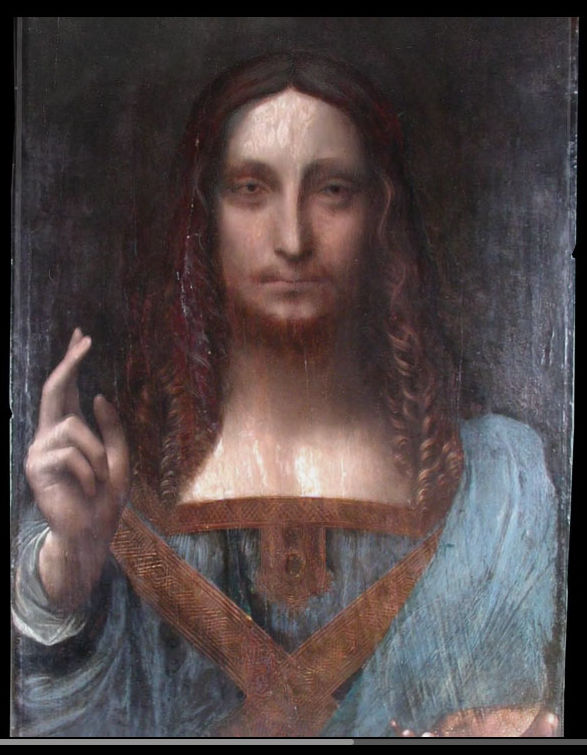



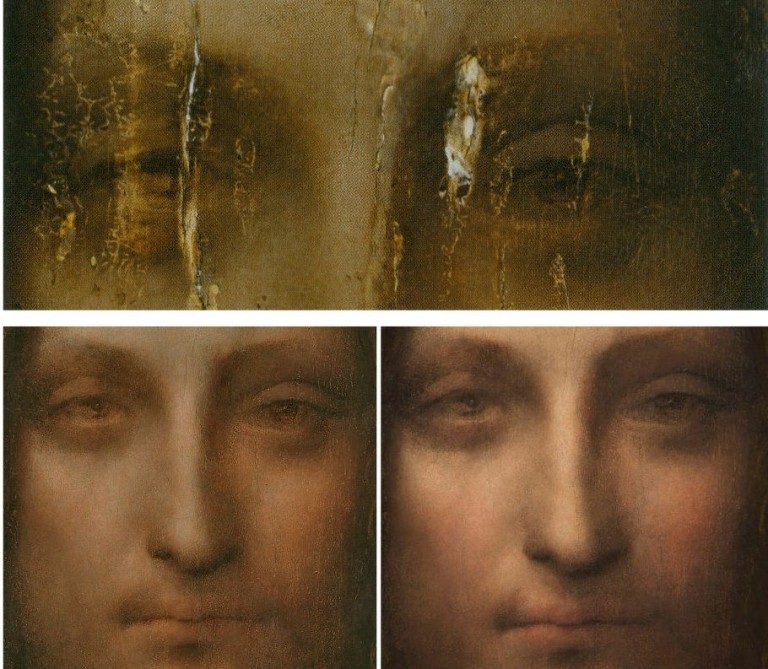
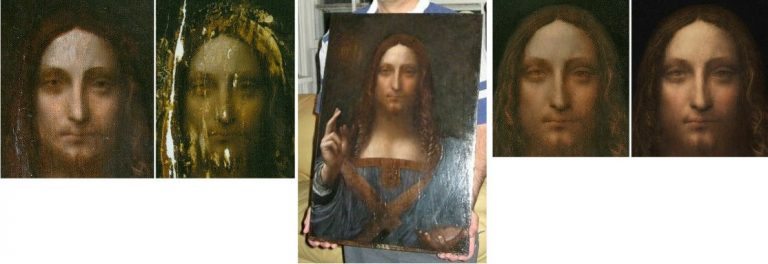
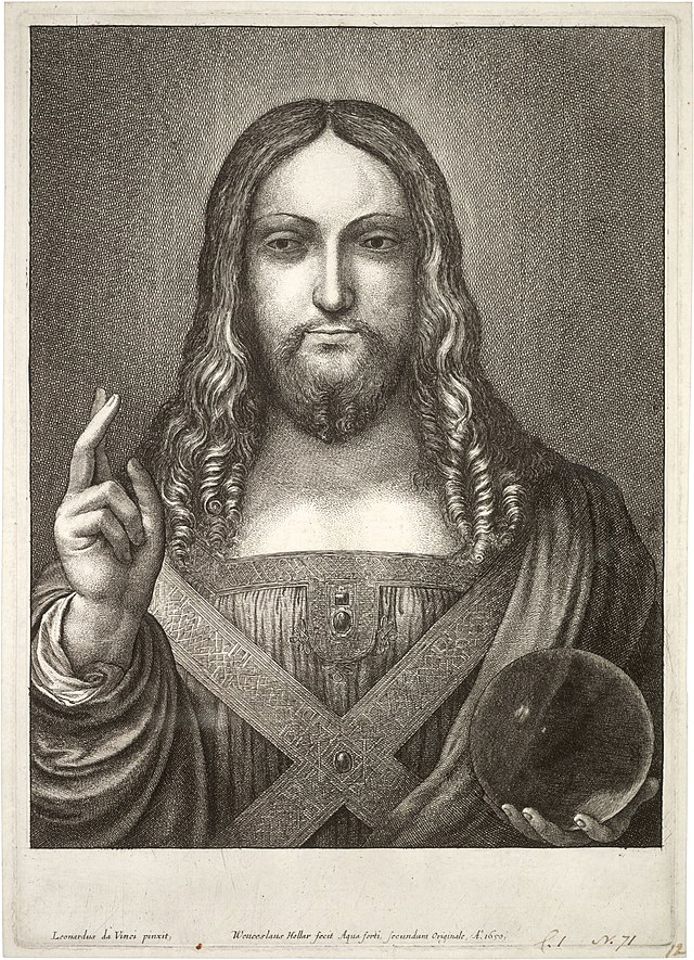

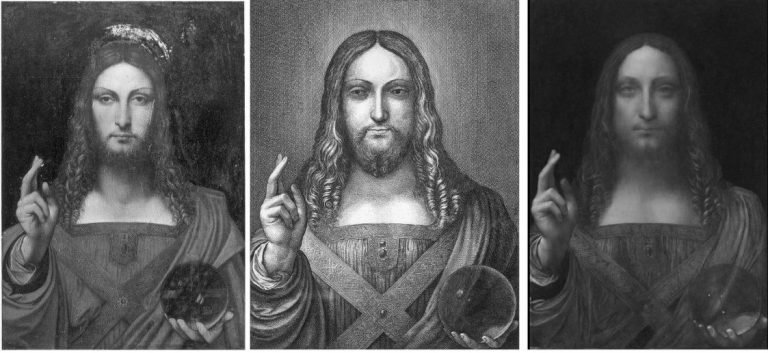
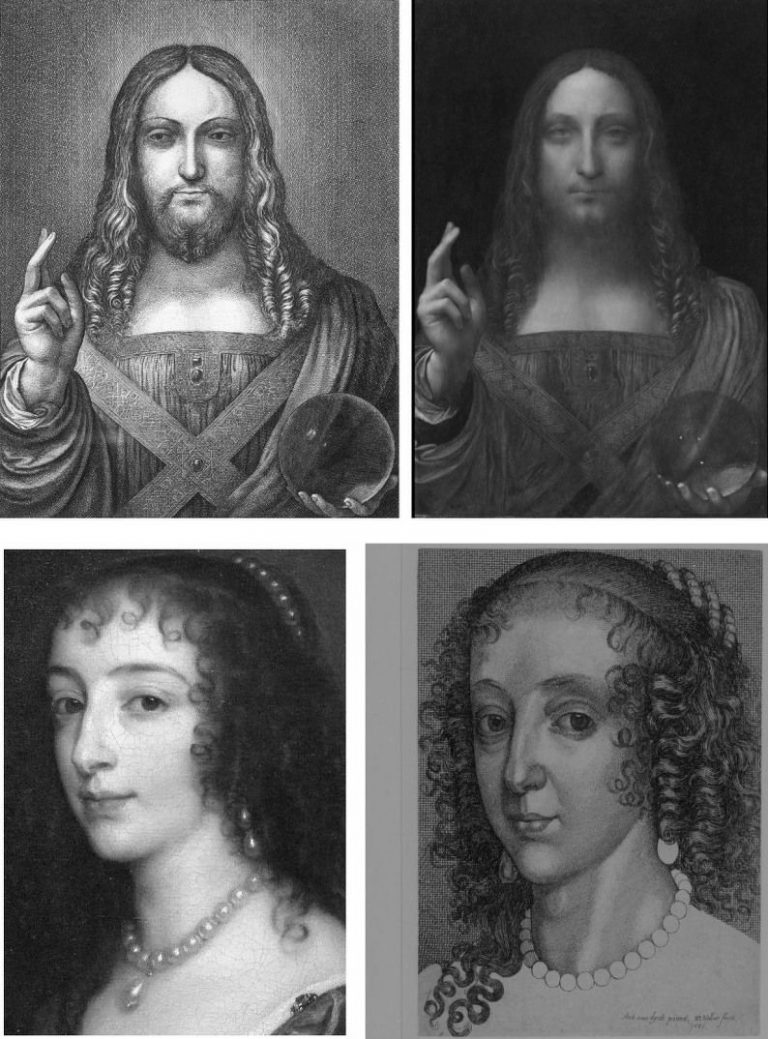
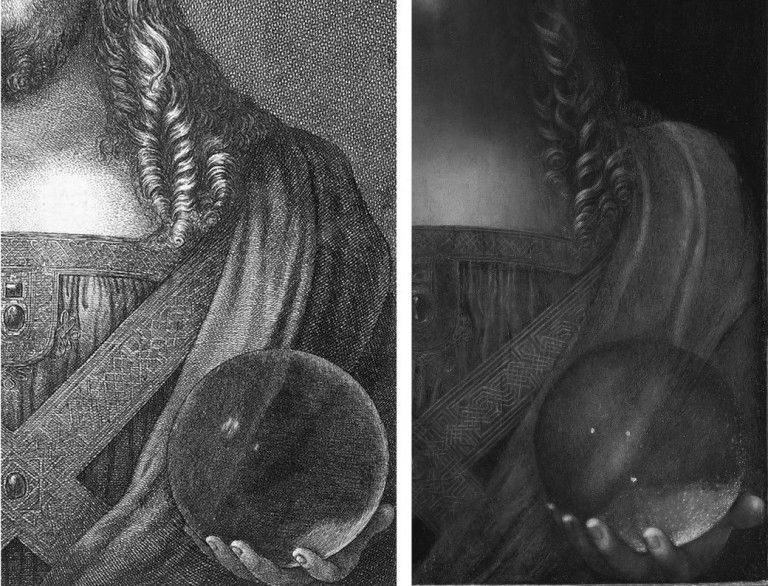
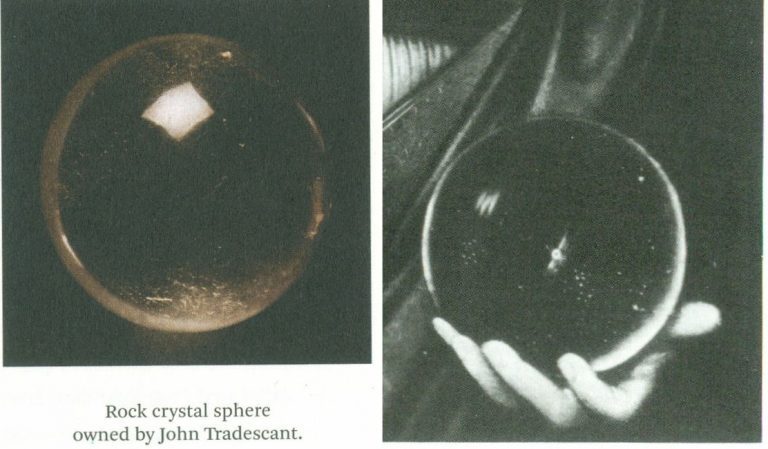
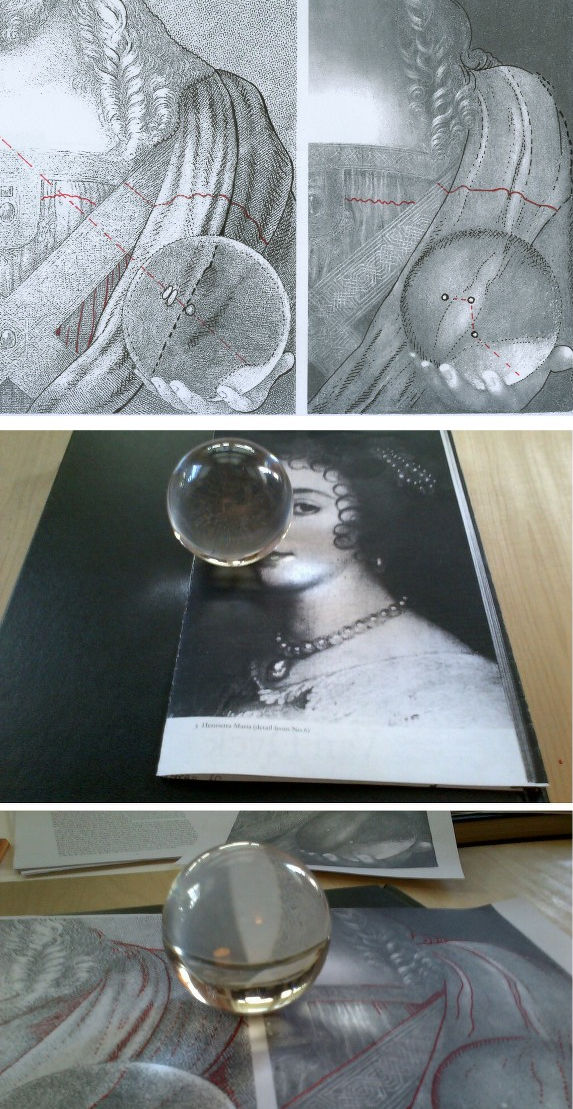
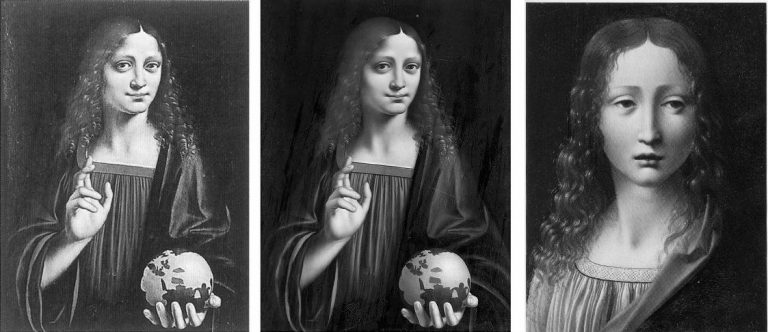
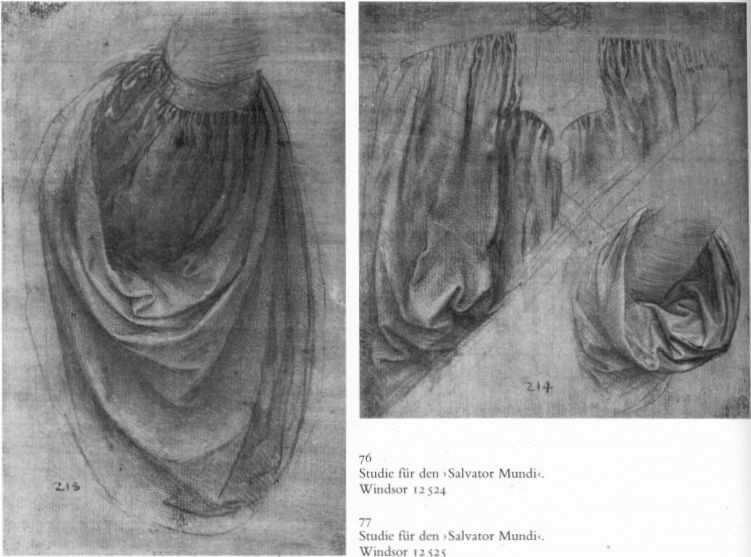
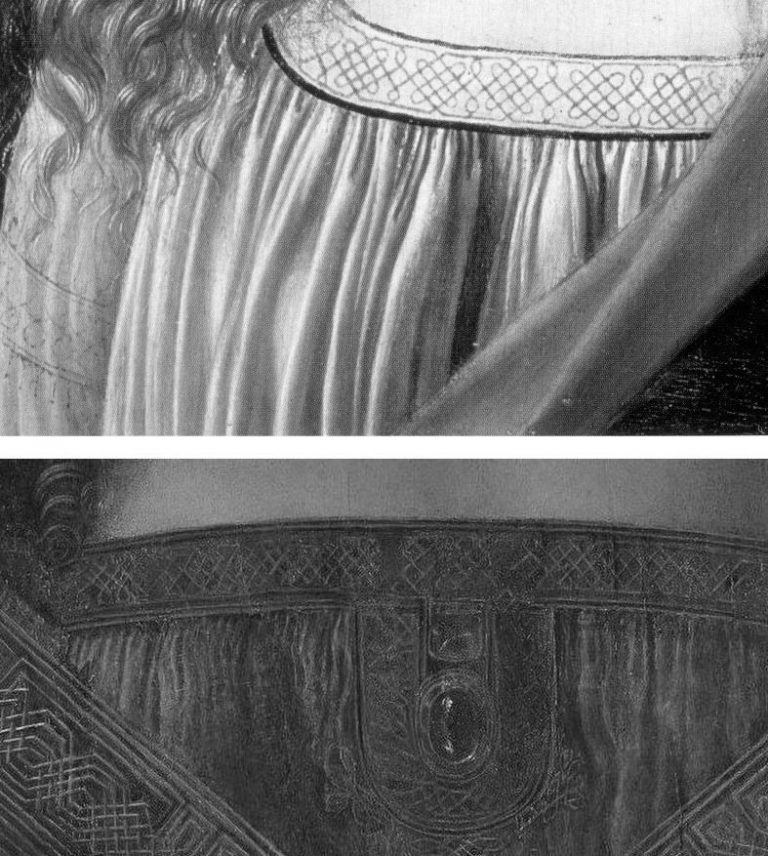
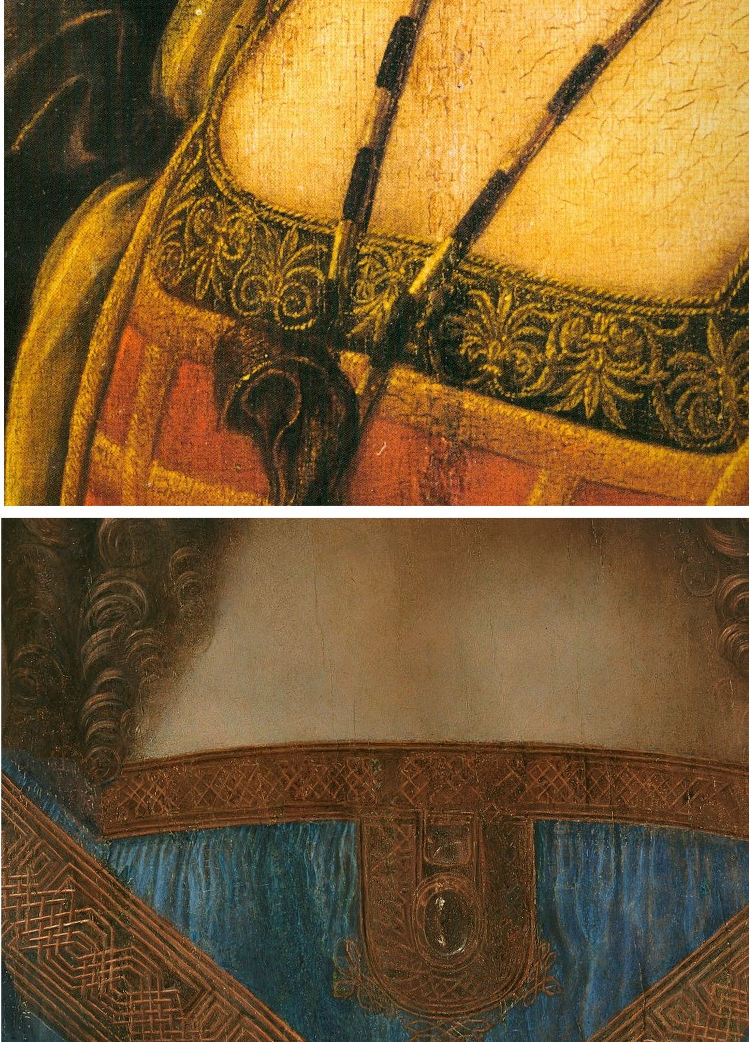
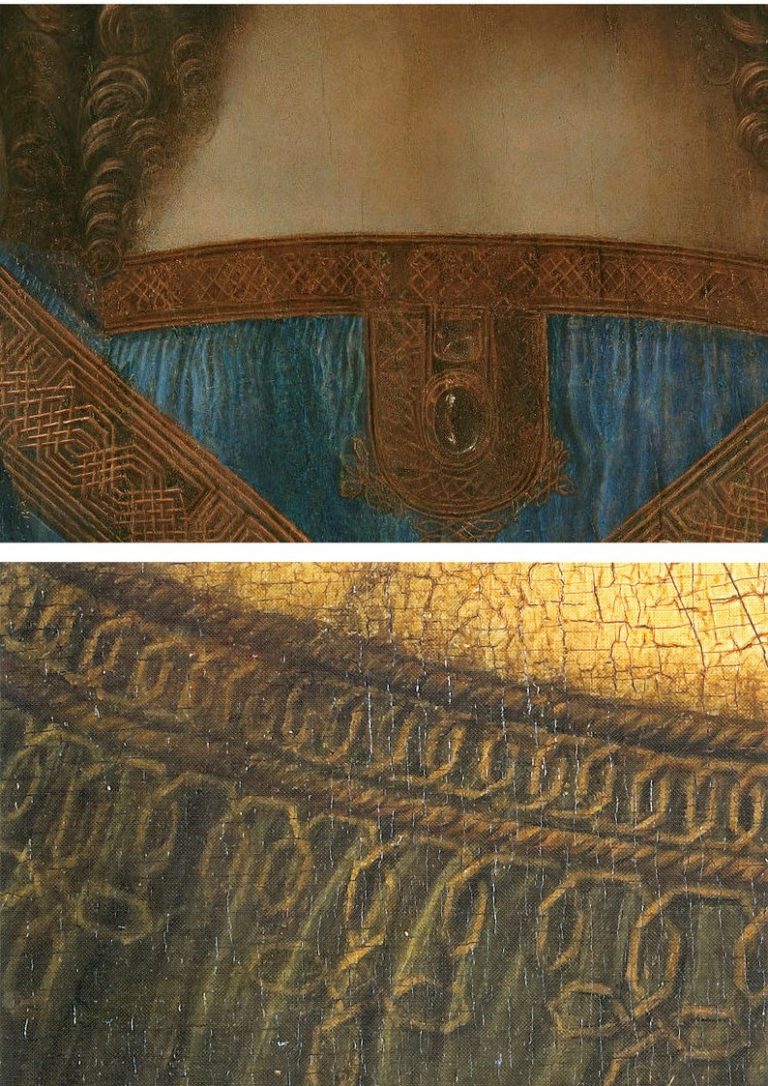

Leave a Reply